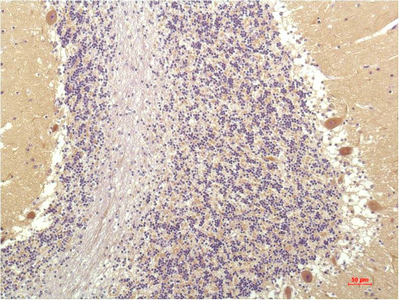SGK1 Polyclonal Antibody
- Catalog No.:YT4268
- Applications:IF;WB;IHC;ELISA
- Reactivity:Human;Mouse;Rat
- Target:
- SGK1
- Fields:
- >>FoxO signaling pathway;>>mTOR signaling pathway;>>PI3K-Akt signaling pathway;>>Aldosterone-regulated sodium reabsorption
- Gene Name:
- SGK1
- Protein Name:
- Serine/threonine-protein kinase Sgk1
- Human Gene Id:
- 6446
- Human Swiss Prot No:
- O00141
- Mouse Gene Id:
- 20393
- Mouse Swiss Prot No:
- Q9WVC6
- Rat Swiss Prot No:
- Q06226
- Immunogen:
- The antiserum was produced against synthesized peptide derived from human SGK. AA range:381-430
- Specificity:
- SGK1 Polyclonal Antibody detects endogenous levels of SGK1 protein.
- Formulation:
- Liquid in PBS containing 50% glycerol, 0.5% BSA and 0.02% sodium azide.
- Source:
- Polyclonal, Rabbit,IgG
- Dilution:
- IF 1:50-200 WB 1:500 - 1:2000. IHC 1:100 - 1:300. ELISA: 1:5000. Not yet tested in other applications.
- Purification:
- The antibody was affinity-purified from rabbit antiserum by affinity-chromatography using epitope-specific immunogen.
- Concentration:
- 1 mg/ml
- Storage Stability:
- -15°C to -25°C/1 year(Do not lower than -25°C)
- Other Name:
- SGK1;SGK;Serine/threonine-protein kinase Sgk1;Serum/glucocorticoid-regulated kinase 1
- Observed Band(KD):
- 57kD
- Background:
- This gene encodes a serine/threonine protein kinase that plays an important role in cellular stress response. This kinase activates certain potassium, sodium, and chloride channels, suggesting an involvement in the regulation of processes such as cell survival, neuronal excitability, and renal sodium excretion. High levels of expression of this gene may contribute to conditions such as hypertension and diabetic nephropathy. Several alternatively spliced transcript variants encoding different isoforms have been noted for this gene. [provided by RefSeq, Jan 2009],
- Function:
- catalytic activity:ATP + a protein = ADP + a phosphoprotein.,enzyme regulation:Two specific sites, one in the kinase domain (Thr-256) and the other in the C-terminal regulatory region (Ser-422), need to be phosphorylated for its full activation.,function:Protein kinase that plays an important role in cellular stress response. Activates certain potassium, sodium, and chloride channels, suggesting an involvement in the regulation of processes such as cell survival, neuronal excitability, and renal sodium excretion. Sustained high levels and activity may contribute to conditions such as hypertension and diabetic nephropathy. Mediates cell survival signals, phosphorylates and negatively regulates pro-apoptotic FOXO3A. Phosphorylates NEDD4L, which leads to its inactivation and to the subsequent activation of various channels and transporters such as ENaC, Kv1.3, or EAAT1.,induction:By serum a
- Subcellular Location:
- Cytoplasm. Nucleus. Endoplasmic reticulum membrane. Cell membrane. Mitochondrion. The subcellular localization is controlled by the cell cycle, as well as by exposure to specific hormones and environmental stress stimuli. In proliferating cells, it shuttles between the nucleus and cytoplasm in synchrony with the cell cycle, and in serum/growth factor-stimulated cells it resides in the nucleus. In contrast, after exposure to environmental stress or treatment with glucocorticoids, it is detected in the cytoplasm and with certain stress conditions is associated with the mitochondria. In osmoregulation through the epithelial sodium channel, it can be localized to the cytoplasmic surface of the cell membrane. Nuclear, upon phosphorylation.; [Isoform 2]: Cell membrane.
- Expression:
- Expressed in most tissues with highest levels in the pancreas, followed by placenta, kidney and lung. Isoform 2 is strongly expressed in brain and pancreas, weaker in heart, placenta, lung, liver and skeletal muscle.
MicroRNA-7-5p regulates human alveolar epithelial sodium channels by targeting the mTORC2/SGK-1 signaling pathway. EXPERIMENTAL LUNG RESEARCH 2016 Jun 22 WB Human 1:1000 A549 cell
SP1-Induced Upregulation of LncRNA AFAP1-AS1 Promotes Tumor Progression in Triple-Negative Breast Cancer by Regulating mTOR Pathway. INTERNATIONAL JOURNAL OF MOLECULAR SCIENCES Yidong Zhou WB Human 1:500 MDA-231 cell,MDA-MB-468 cell
- June 19-2018
- WESTERN IMMUNOBLOTTING PROTOCOL
- June 19-2018
- IMMUNOHISTOCHEMISTRY-PARAFFIN PROTOCOL
- June 19-2018
- IMMUNOFLUORESCENCE PROTOCOL
- September 08-2020
- FLOW-CYTOMEYRT-PROTOCOL
- May 20-2022
- Cell-Based ELISA│解您多样本WB检测之困扰
- July 13-2018
- CELL-BASED-ELISA-PROTOCOL-FOR-ACETYL-PROTEIN
- July 13-2018
- CELL-BASED-ELISA-PROTOCOL-FOR-PHOSPHO-PROTEIN
- July 13-2018
- Antibody-FAQs
- Products Images

- SP1-Induced Upregulation of LncRNA AFAP1-AS1 Promotes Tumor Progression in Triple-Negative Breast Cancer by Regulating mTOR Pathway. INTERNATIONAL JOURNAL OF MOLECULAR SCIENCES Yidong Zhou WB Human 1:500 MDA-231 cell,MDA-MB-468 cell
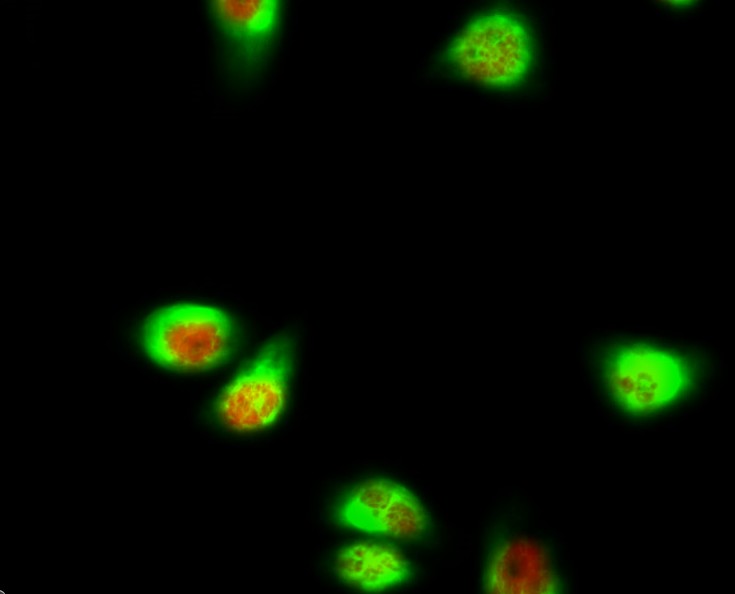
- Immunofluorescence analysis of Hela cell. 1,SGK1 Polyclonal Antibody(red) was diluted at 1:200(4° overnight). α-SMA Monoclonal Antibody(6A12)(green) was diluted at 1:200(4° overnight). 2, Goat Anti Rabbit Alexa Fluor 594 Catalog:RS3611 was diluted at 1:1000(room temperature, 50min). Goat Anti Mouse Alexa Fluor 488 Catalog:RS3208 was diluted at 1:1000(room temperature, 50min).
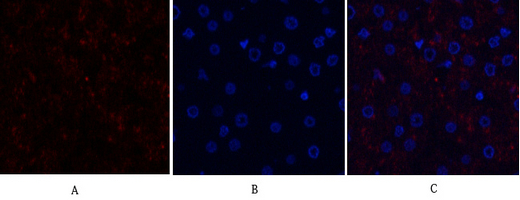
- Immunofluorescence analysis of human-liver tissue. 1,SGK1 Polyclonal Antibody(red) was diluted at 1:200(4°C,overnight). 2, Cy3 labled Secondary antibody was diluted at 1:300(room temperature, 50min).3, Picture B: DAPI(blue) 10min. Picture A:Target. Picture B: DAPI. Picture C: merge of A+B

- Immunofluorescence analysis of rat-lung tissue. 1,SGK1 Polyclonal Antibody(red) was diluted at 1:200(4°C,overnight). 2, Cy3 labled Secondary antibody was diluted at 1:300(room temperature, 50min).3, Picture B: DAPI(blue) 10min. Picture A:Target. Picture B: DAPI. Picture C: merge of A+B
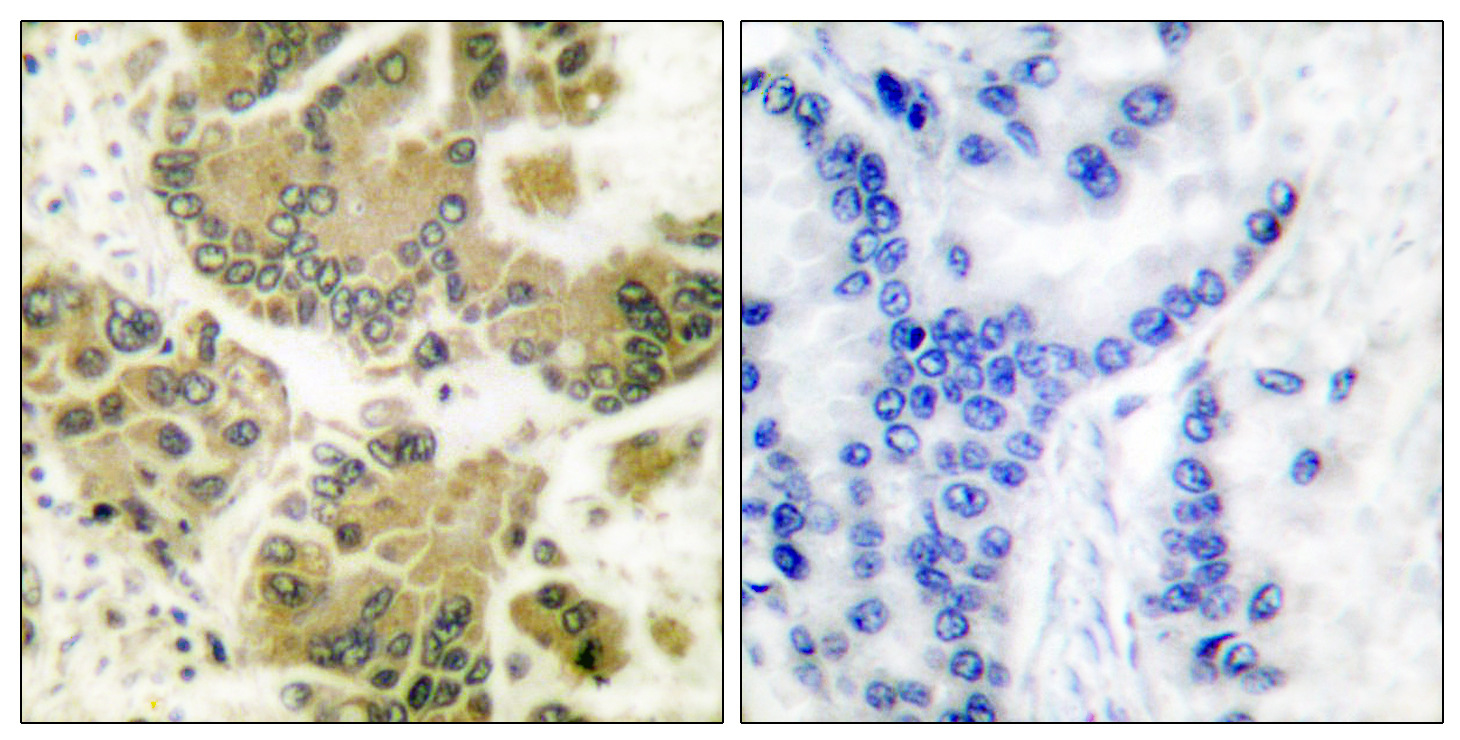
- Immunohistochemistry analysis of paraffin-embedded human breast carcinoma tissue, using SGK Antibody. The picture on the right is blocked with the synthesized peptide.
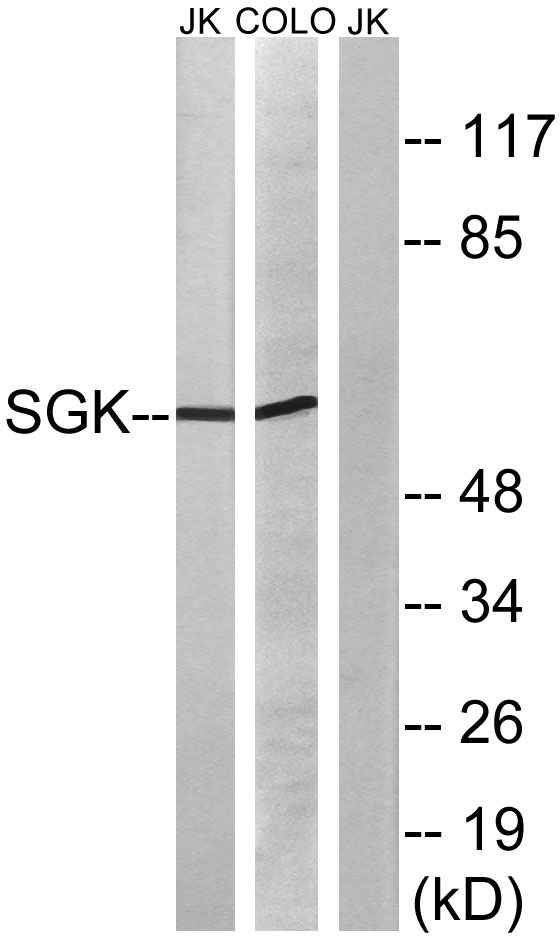
- Western blot analysis of lysates from Jurkat and COLO205 cells, using SGK Antibody. The lane on the right is blocked with the synthesized peptide.
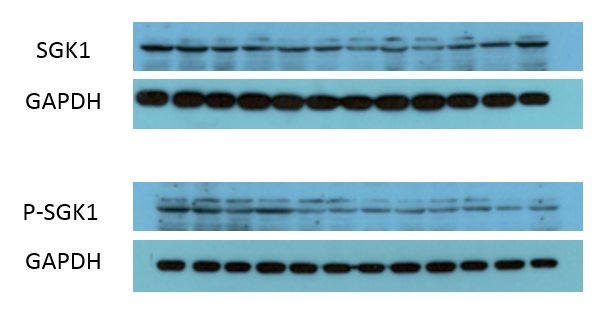
- The picture was kindly provided by our customer. Primary antibody was diluted at 1:2000. Loading control antibody was diluted at 1:20000

